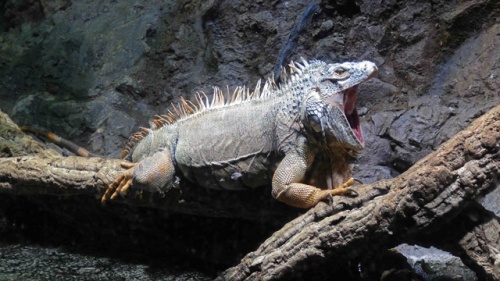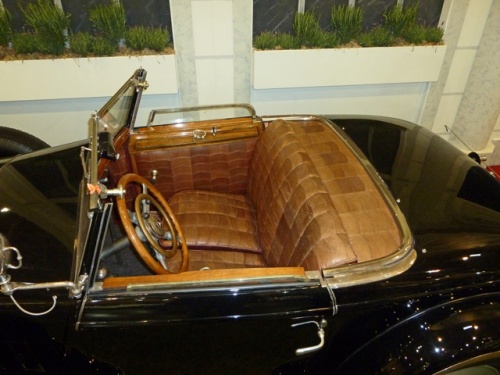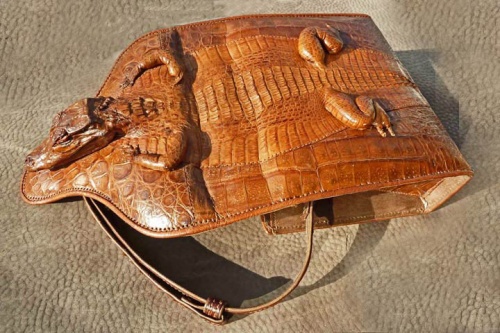Difference between revisions of "Reptile leather"
| (6 intermediate revisions by one user not shown) | |||
| Line 5: | Line 5: | ||
<p align=center> | <p align=center> | ||
| − | [[bild:Leguan-01.jpg| | + | [[bild:Leguan-01.jpg|500px]] |
| − | + | ||
</p> | </p> | ||
==Reptile leather== | ==Reptile leather== | ||
| − | + | Reptile [[leather]] comes from [[Snakeskin|snakes]], [[Lizard leather|lizards]], [[Crocodile leather|crocodiles]] and [[Alligator leather|alligators]]. It is usually used to make expensive [[leather shoes|shoes]] and [[Leather handbags|handbags]]. | |
| − | The difficulty in | + | The difficulty in [[leather production|producing leather]] from reptiles is, generally, that their skin structure is less stretchy and has a lower total usable surface, compared with mammals. Undamaged reptile skins are rare and, in contrast to cattle, the rest of the animals cannot be used profitably for other purposes (food production etc.). For crocodiles, only the belly and skins of younger animals are processed as leather. This makes reptile leather significantly more expensive. Usually hides between [[Measures and weights|28 and 35 cm width]] are used. |
| − | |||
| − | + | <p align=center> | |
| + | [[bild:Krokodil-ausgestopft.jpg|500px]] | ||
| + | </p> | ||
| − | These leathers come from reptile farms such as the Samut Prakarn Farm in Bangkok, Thailand, where about | + | |
| + | Since 1976, the threat of extinction has prevented the sale of many reptile leathers or they can only be sold under strict rules (CITES - Convention on International Trade in Endangered Species of wild fauna and flora). | ||
| + | |||
| + | Legitimately sold reptile leather has a seal of the International Reptile Federation and a reptile species protection label, which gives information about the year and place of manufacture, manufacturing company, reptile species and article group by means of a number code. | ||
| + | |||
| + | These leathers come from reptile farms such as the Samut Prakarn Farm in Bangkok, Thailand, where about 20,000 reptiles are kept on 400,000 square meters and about 10,000 hides are produced each year. A farm of comparable size is also located in Mombasa, Kenya. | ||
<p align=center> | <p align=center> | ||
| − | [[bild:Python-02.jpg| | + | [[bild:Python-02.jpg|500px]] |
| − | [[bild:schlangenlederstiefel.JPG| | + | </p> |
| + | <p align=center> | ||
| + | [[bild:schlangenlederstiefel.JPG|500px]] | ||
</p> | </p> | ||
<p align=center> | <p align=center> | ||
| Line 31: | Line 38: | ||
<p align=center> | <p align=center> | ||
| − | [[bild:Auto-Leguan-03.jpg| | + | [[bild:Auto-Leguan-03.jpg|500px]] |
| − | [[bild:Leguan-Handtasche-02.jpg| | + | </p> |
| + | <p align=center> | ||
| + | [[bild:Leguan-Handtasche-02.jpg|500px]] | ||
</p> | </p> | ||
<p align=center> | <p align=center> | ||
| Line 45: | Line 54: | ||
<p> </p> | <p> </p> | ||
| − | == | + | ==Cocco-Ligator== |
| − | In Italy there is a material which is used for [[leather bag|bags]] | + | In Italy, there is a material which is used for [[leather bag|bags]] called "Cocco-Ligator". The manufacturing process appears to be patented. In this process, [[Bonded leather|fibres]] of [[split leather]] from [[Crocodile leather|crocodiles]] and [[Alligator leather|alligators]] are heated, then provided with a [[finish|high-gloss surface]] and then glued to a further leather layer. The method is also referred to as the "ligathor method". The surface is [[Embossed leather|embossed]] to look like a crocodile's skin. |
| − | Although this leather is advertised as innovative and as something special, | + | Although this leather is advertised as innovative and as something special, it is only [[Bonded leather|heat-bonded leather fibres]] from [[split leather]], which is then glued onto another leather. It is questionable whether the material should be [[leather#What materials can be called leather?|declared as "leather"]] at all. The consumer might think that it has to do with real [[exotic leather]], as it is according to the description, but the base material is waste obtained from the production of reptile leather. |
| − | == [[Leather videos|Video]] about leather of different animal species== | + | == [[Leather videos|Video]] about leather of different [[exotic leather|animal species]]== |
<br> | <br> | ||
<p align=center> | <p align=center> | ||
| − | <flashow> | + | <flashow>//www.youtube.com/v/-tJtZmJCWLw&fs=1&color1=0x660000&color2=0x550000&border=1|width=500|height=281,25</flashow> |
</p> | </p> | ||
<p align=center> | <p align=center> | ||
| − | ''Leather of different animal species. - Exotic leather.'' | + | ''Leather of different animal species. - [[Exotic leather]].'' |
</p> | </p> | ||
Latest revision as of 07:48, 28 March 2023
Contents
Reptile leather
Reptile leather comes from snakes, lizards, crocodiles and alligators. It is usually used to make expensive shoes and handbags.
The difficulty in producing leather from reptiles is, generally, that their skin structure is less stretchy and has a lower total usable surface, compared with mammals. Undamaged reptile skins are rare and, in contrast to cattle, the rest of the animals cannot be used profitably for other purposes (food production etc.). For crocodiles, only the belly and skins of younger animals are processed as leather. This makes reptile leather significantly more expensive. Usually hides between 28 and 35 cm width are used.
Since 1976, the threat of extinction has prevented the sale of many reptile leathers or they can only be sold under strict rules (CITES - Convention on International Trade in Endangered Species of wild fauna and flora).
Legitimately sold reptile leather has a seal of the International Reptile Federation and a reptile species protection label, which gives information about the year and place of manufacture, manufacturing company, reptile species and article group by means of a number code.
These leathers come from reptile farms such as the Samut Prakarn Farm in Bangkok, Thailand, where about 20,000 reptiles are kept on 400,000 square meters and about 10,000 hides are produced each year. A farm of comparable size is also located in Mombasa, Kenya.
Lizard leather. Handbag of green iguana.
Cocco-Ligator
In Italy, there is a material which is used for bags called "Cocco-Ligator". The manufacturing process appears to be patented. In this process, fibres of split leather from crocodiles and alligators are heated, then provided with a high-gloss surface and then glued to a further leather layer. The method is also referred to as the "ligathor method". The surface is embossed to look like a crocodile's skin.
Although this leather is advertised as innovative and as something special, it is only heat-bonded leather fibres from split leather, which is then glued onto another leather. It is questionable whether the material should be declared as "leather" at all. The consumer might think that it has to do with real exotic leather, as it is according to the description, but the base material is waste obtained from the production of reptile leather.
Video about leather of different animal species
Leather of different animal species. - Exotic leather.
Additional information
Other exotic leather
- Alligator leather
- Alpaca fur
- Antelope leather
- Armadillo leather
- Bird leather
- Bull testicles
- Caiman leather
- Camel leather
- Carpincho leather
- Cat fur
- Chicken leather
- Crocodile leather
- Dog leather
- Donkey leather
- Elephant leather
- Fish leather: Eel, shark, salmon, moray eel, stingray and many others
- Frog leather - Toad leather
- Giraffe leather
- Hippo Leather
- Horsehide - Horse leather
- Kangaroo leather
- Llama Fur
- Lizard leather
- Ostrich leather
- Pangolin leather
- Peccary leather
- Rumen leather
- Sealskin leather
- Snakeskin
- Turtle skin
- Walrus leather
- Yak leather
- Zebra hide















 a kotori web solution
a kotori web solution